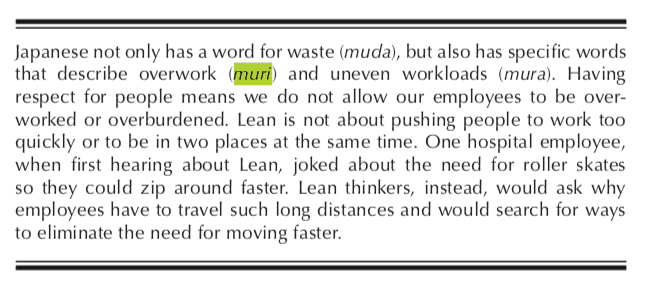Recently, I blogged about how a Lean hospital would focus on reducing overwork on nurses and other staff:
Another term that could be used is “overburden.” The Japanese word for this is “muri,” for what it's worth.
Many Lean practitioners talk about reducing waste. The Japanese word for this is “muda.” It's generally good to reduce waste for a number of reasons: If it improves safety or quality, if it makes work easier, if it improves flow.
But, if we're not careful, local waste reduction can cause overburden or unevenness (“mura”) in other departments.
Let's say the operating rooms reduce waste (such as reducing the room turnover time between cases) and that improves their productivity — they can do more cases per day.
That might cause a problem downstream in the nursing units that receive patients after surgery. The was reduction in the surgical department has created (or worsened) overburden in the nursing unit.
Christoph Roser wrote a great blog post about this recently. I saw him share it on LinkedIn and was part of the discussion there.
Check out my podcast with Christoph if you like:
“I wish healthcare organizations focused more on reducing overburden on nurses, doctors, and others.”
Overburden causes problems like:
- Stress and burnout
- Safety risks, errors, and harm
- Lower quality
- Lower patient satisfaction
I wrote about this in my book Lean Hospitals.
As I shared on LinkedIn recently… an excerpt from the book:
“The Japanese not only has a word for waste (muda), but also has specific words that describe overwork (muri) and uneven workloads (mura). Having respect for people means we do not allow our employees to be over- worked or overburdened.”

I added, on LinkedIn:
“It's unfair to ask a nurse to do 75 or 80 minutes worth of work in an hour. It's impossible and it puts nurses in a horrible position of having to cut corners or decide which tasks can be skipped. And, of course, if skipping
- Please don't focus only on waste (
muda ), especially if the waste reduction is done in just one part of the value stream - Make sure you also focus on overburden… and “unevenness” often creates short-term overburden. It's not enough to say, “On average, you can handle the workload” over the entirety of a shift. People need to have enough capacity each hour. They can't be expected to do three things at once.
What are you or your organization doing to focus on all three of “the 3Ms” — muda, muri, and mura?
Or, just call it “waste, overburden, and unevenness.”
If the workload is too heavy, what are you doing about it? If your leaders and executives are unaware of the overburden, how can you help them see? Hint: it might mean a “gemba walk” that goes beyond going to stare at a metrics board…
What do you think? Please scroll down (or click) to post a comment. Or please share the post with your thoughts on LinkedIn – and follow me or connect with me there.
Did you like this post? Make sure you don't miss a post or podcast — Subscribe to get notified about posts via email daily or weekly.
Check out my latest book, The Mistakes That Make Us: Cultivating a Culture of Learning and Innovation:










This article reminds me of an issue that was on the ballot for Massachusetts this year. Question #1 revolved around imposing limits on the number of patients they can be assigned in an attempt to reduce the mura that came with an excess number of patients being serviced simultaneously by a single nurse. However, this got a lot of push back from fellow nurses and hospital groups since some patients would be turned away or forced to wait if these limits were imposed, which resembles muda. In the end, 70% voted not to impose limits on the nurse to patient ratio. It reasonable and understandable that people would want the nurses to reduce muda and take on patients as fast as possible. However, there is a quality of life aspect to consider for the nurses as well who have to stretch themselves out as far as possible in order to keep up with the extra work being handed to them. The question here is whether you want to be serviced as soon as possible at a hospital by someone who has less time to do a quality job for you, or be serviced at the hospitals convenience by someone who has the time to do quality work for you.
Thanks for the comment, Matthew. I’m skeptical at attempts to legislate improvement.
One downside that’s feared when hospitals have a mandated nurse ratio is that they’ll then try to save money by cutting support staff, like CNAs, techs, etc. That means nurses might end up doing more non-nursing work and is the patient really any better off?
I’d rather see hospitals do all they can to maximize nurse time — reducing waste and having the proper number of support staff needed to, well, provide support to the nurses. There are different ways to save money. Traditional cost-cutting usually hurts quality and patient satisfaction. Lean means having the right number of staff in the right roles doing the right work at the right time. Sometimes spending more on staff leads to better outcome and lower costs…
I never thought about how reducing waste in one place could cause problems down the line. This is very insightful because you might not realize that you are causing more problems by solving one. So you could save time and get more surgeries done but this could lead to too many patients to take care of at once potentially resulting in an injury or issues with a patient. This could lead to a lawsuit and many other problems so you definitely have to keep this in mind when reducing waste.
Discussion from Linkedin:
And the discussion about the book excerpt I posted: